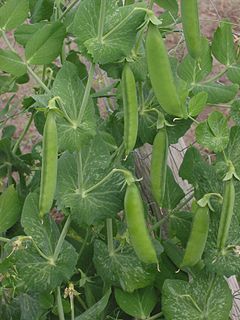Utricularia reflexa is a small to medium-sized suspended aquatic carnivorous plant that belongs to the genus Utricularia. U. reflexa is endemic to Africa and can be found in Benin, Burkina Faso, Burundi, Cameroon, Chad, the Central African Republic, Côte d'Ivoire, the Democratic Republic of the Congo, Gambia, Ghana, Guinea, Kenya, Madagascar, Malawi, Mali, Niger, Nigeria, Senegal, Sierra Leone, Sudan, Tanzania, Togo, Uganda, Zambia, and Zimbabwe.

Utricularia stellaris is a medium to large sized suspended aquatic carnivorous plant that belongs to the genus Utricularia. U. stellaris is native to Africa, tropical Asia, and northern Australia.
Peter Geoffrey Taylor (1926–2011) was a British botanist who worked at Royal Botanic Gardens, Kew throughout his career in botany. Taylor was born in 1926 and joined the staff of the herbarium at Kew in 1948. He published his first new species, Utricularia pentadactyla, in 1954. In 1973, Taylor was appointed curator of the orchid division of the herbarium and, according to Kew, "under his direction, orchid taxonomy was revitalised and its horticultural contacts strengthened."
Utricularia mannii is a small, perennial, epiphytic carnivorous plant that belongs to the genus Utricularia and is the only member of Utricularia sect. Chelidon. U. mannii is endemic to tropical Africa, particularly the islands in the Gulf of Guinea and the adjacent mainland. It grows as an epiphytic plant on mossy tree trunks in rain forests at altitudes from 500 m (1,640 ft) to 2,100 m (6,890 ft). It has been collected in flower between April and November. It was originally published and described by Daniel Oliver in 1865 and placed in its own section, Chelidon, in 1986 by Peter Taylor.
Utricularia appendiculata is a medium-sized, probably perennial, terrestrial carnivorous plant that belongs to the genus Utricularia and is the only member of Utricularia sect. Oliveria. U. appendiculata is endemic to Africa, where it can be found in Burundi, Cameroon, the Central African Republic, the Democratic Republic of the Congo, Gabon, Madagascar, Malawi, Mozambique, Tanzania, Uganda, and Zimbabwe. It grows as a terrestrial plant in wet Sphagnum bogs, damp sandy savannas, or in peaty marshes at altitudes from 1,500 m (4,921 ft) to 1,860 m (6,102 ft), but as low as 700 m (2,297 ft) in the Central African Republic. It flowers mostly in the wet season. It was originally published and described by Eileen Adelaide Bruce in 1933 and was placed in its own section, Oliveria, in 1986 by Peter Taylor.
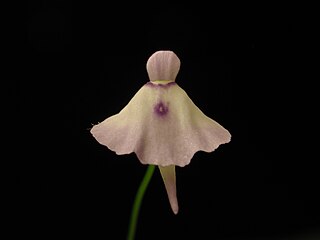
Utricularia pubescens is a small to medium-sized, probably annual, terrestrial or lithophytic carnivorous plant that belongs to the genus Utricularia and is the only member of Utricularia sect. Lloydia. U. pubescens is native to India, tropical Africa, and Central and South America. It was originally published and described by James Edward Smith in 1819 and placed in its own section, Lloydia, by Peter Taylor in 1986. It grows as a terrestrial or lithophytic plant in boggy grasslands in damp peaty soils at altitudes from sea level to 1,900 m (6,234 ft). This species possesses small peltate leaves, which are diagnostic for this species in the genus.
Utricularia sect. Avesicarioides is a section in the genus Utricularia. The two species in this section are small rheophytic carnivorous plants native to western Africa. Sadashi Komiya originally described and published this section in his 1973 taxonomic treatment of the genus. Peter Taylor revised and refined the section in his 1989 monograph on the genus.

Utricularia sect. Nigrescentes is a section in the genus Utricularia. The three species in this section are small terrestrial carnivorous plants native to tropical Africa, Asia, and Australia. Daniel Oliver originally validly described and published this section in 1859, but did not specify the rank used by the group. Sadashi Komiya revised the section in 1973. Peter Taylor, in his 1989 taxonomic monograph on the genus, placed this section within subgenus Utricularia. More recent phylogenetic data and revisions have reinstated subgenus Bivalvaria and have placed this section within it.
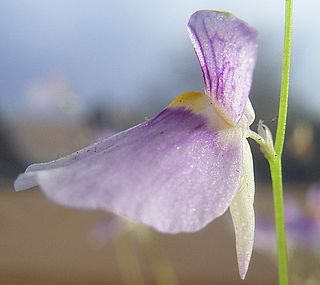
Utricularia sect. Aranella is a section in the genus Utricularia. The ten species in this section are small terrestrial carnivorous plants native to tropical South America with one species also extending into tropical Africa. John Hendley Barnhart originally described and published this section in 1913 as a separate genus, Aranella. Sadashi Komiya revised the genus Utricularia in a 1973 taxonomic review and placed Barnhart's genus at the rank of subgenus within Utricularia. Peter Taylor then published his taxonomic monograph of Utricularia in 1986 in which he reduced Komiya's subgenus to the rank of section, placing it within subgenus Utricularia. More recent phylogenetic data and revisions have reinstated subgenus Bivalvaria and have placed this section within it.
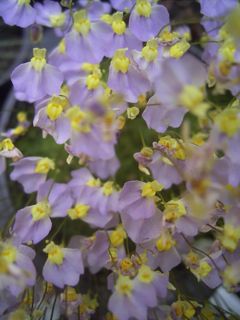
Utricularia sect. Calpidisca is a section in the genus Utricularia. The ten species in this section are small terrestrial carnivorous plants native to Africa with one species extending its range into Mexico and another that extends into Asia as far as India. John Hendley Barnhart originally described and published this section in 1916 as a separate genus, Calpidisca. Sadashi Komiya revised the genus Utricularia in a 1973 taxonomic review and placed Barnhart's genus at the rank of section within Utricularia. Peter Taylor then published his taxonomic monograph of Utricularia in 1986 in which he placed Komiya's section within subgenus Utricularia. More recent phylogenetic data and revisions have reinstated subgenus Bivalvaria and have placed this section within it.

Utricularia arenaria is a small annual carnivorous plant that belongs to the genus Utricularia. It is native to tropical and southern Africa, where it can be found in Angola, Burundi, Cameroon, Côte d'Ivoire, the Democratic Republic of the Congo, Ethiopia, Gabon, Ghana, Kenya, Madagascar, Malawi, Mali, Mozambique, Nigeria, Senegal, Sierra Leone, South Africa, Sudan, Tanzania, Togo, Uganda, Zambia, and Zimbabwe. There has also been a single collection from central India in Madhya Pradesh. U. arenaria grows as a terrestrial plant in damp, sandy or peaty soils in swampy grasslands or marshes at altitudes from near sea level to 2,400 m (7,874 ft). It was originally described and published by Alphonse Pyrame de Candolle in 1844.
Utricularia firmula is a small annual carnivorous plant that belongs to the genus Utricularia. It is native to tropical and southern Africa, where it can be found in Angola, Cameroon, Côte d'Ivoire, the Democratic Republic of the Congo, Ghana, Guinea, Guinea-Bissau, Kenya, Liberia, Madagascar, Malawi, Mali, Mozambique, Nigeria, Senegal, Sierra Leone, South Africa, Sudan, Tanzania, The Gambia, Togo, Uganda, Zambia, and Zimbabwe. U. firmula grows as a terrestrial plant in damp, sandy or peaty soils in grasslands or on wet, mossy rocks, often as a weed in rice fields at altitudes from near sea level to 2,100 m (6,890 ft). It typically flowers toward the end of the wet season. It was originally named by Friedrich Welwitsch but formally described and published by Daniel Oliver in 1865.
Utricularia microcalyx is a small to medium-sized annual carnivorous plant that belongs to the genus Utricularia. It is native to tropical Africa, where it can be found in the Democratic Republic of the Congo and Zambia. U. microcalyx grows as a terrestrial plant in damp, sandy or peaty soils in grasslands at altitudes from 1,200 m (3,937 ft) to 1,650 m (5,413 ft). It typically flowers between February and July. It was originally described and published by Peter Taylor in 1964 as a variety of U. welwitschii. Taylor elevated this variety to the species level in 1971.
Utricularia pentadactyla is a small annual carnivorous plant that belongs to the genus Utricularia. It is native to tropical Africa, where it can be found in Angola, Burundi, the Democratic Republic of the Congo, Ethiopia, Kenya, Malawi, Sudan, Tanzania, Uganda, Zambia, and Zimbabwe. U. pentadactyla grows as a terrestrial plant in damp, sandy or peaty soils in grasslands or shallow soils over rock at altitudes from 1,500 m (4,921 ft) to 2,100 m (6,890 ft). It was originally described and published by Peter Taylor in 1954, the first Utricularia species described by Taylor.
Utricularia troupinii is a small, probably annual, carnivorous plant that belongs to the genus Utricularia. It is endemic to Burundi and Rwanda. U. troupinii grows as a terrestrial plant in wet grasslands or marshes at altitudes from 1,900 m (6,234 ft) to 2,500 m (8,202 ft). It was originally described and published by Peter Taylor in 1971, but was identified in 1964 by Taylor as a possible short spurred form of U. welwitschii.

Utricularia sect. Oligocista is the largest section in the genus Utricularia. The 42 species in this section are small to medium-sized terrestrial carnivorous plants native throughout the tropics, with six species in the Americas, ten in Africa, five in Australia, and the remainder in Asia, with 17 mostly native to peninsular India. Alphonse Pyrame de Candolle originally described and published this section in 1844. Peter Taylor published his taxonomic monograph of Utricularia in 1986, in which he placed this section within subgenus Utricularia. More recent phylogenetic data and revisions have reinstated subgenus Bivalvaria and have placed this section within it.
Utricularia andongensis is a small, probably perennial, carnivorous plant that belongs to the genus Utricularia. It is endemic to tropical Africa, where it can be found in Angola, Cameroon, the Central African Republic, the Democratic Republic of the Congo, Gabon, Guinea, Liberia, Nigeria, Sierra Leone, Sudan, Tanzania, Togo, Uganda, and Zambia. U. andongensis grows as a terrestrial or lithophytic plant on wet, bare rocks or among mosses in grasslands at altitudes from 240 m (787 ft) to 1,800 m (5,906 ft). It was originally named by Friedrich Welwitsch but formally described and published by William Philip Hiern in 1900.
Utricularia scandens is a small, probably annual carnivorous plant that belongs to the genus Utricularia. It has a wide native distribution that includes Africa and Asia. U. scandens grows as a terrestrial plant in wet grasslands and bogs at lower altitudes around sea level up to 2,300 m (7,546 ft). It was originally described by Ludwig Benjamin in 1847. There is a significant amount of synonymy established for this species, in part because of its large distribution and variable morphology.
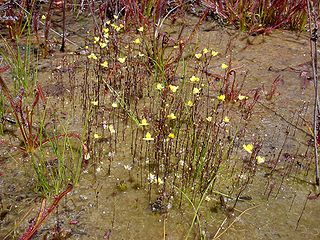
Utricularia sect. Setiscapella is a section in the genus Utricularia that contains small or medium-sized terrestrial or subaquatic species. Most plants in this section are endemic to Central and South America with the exceptions of Utricularia stanfieldii, which is endemic to Africa, and Utricularia subulata which is almost pantropical. It was first described by John Hendley Barnhart in 1916 at the rank of genus. In 1973, Sadashi Komiya reduced the genus to a subgenus of the genus Utricularia. In his 1986 monograph on the genus, Peter Taylor reorganized the genus and reduced this to the rank of section.

The Genus Utricularia: A Taxonomic Monograph is a monograph by Peter Taylor on the carnivorous plant genus Utricularia, the bladderworts. It was published in 1989 by Her Majesty's Stationery Office (HMSO) as the fourteenth entry in the Kew Bulletin Additional Series. It was reprinted for The Royal Botanic Gardens, Kew in 1994.
